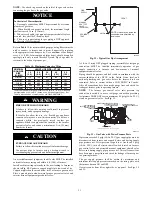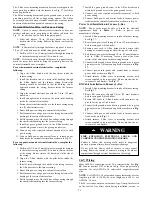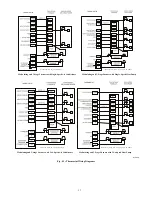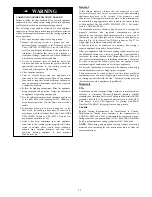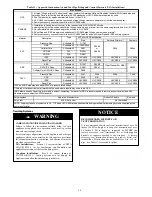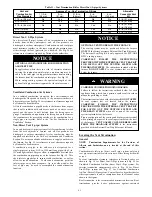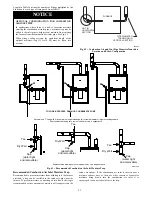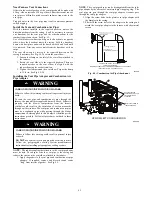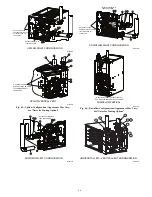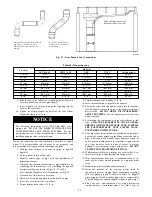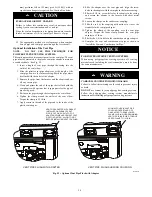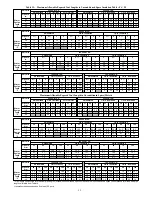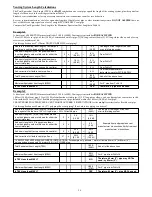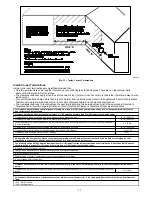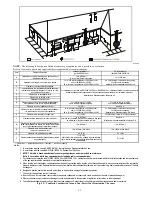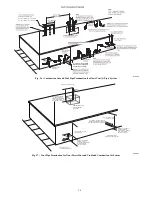
44
The trap can be constructed from a running tee of the same
diameter of the intake air pipe with
EITHER
a removable cap
attached to a 6-inch long pipe connected to the tee or the External
Vent Trap Kit to help prevent contaminants from entering the
furnace. See Fig. 43.
The External Vent Trap Kit accessory may be used as a trap for the
combustion air inlet pipe if a large amount of moisture must be
removed. The drain line may be connected to the same drain as the
furnace condensate and the evaporator coil condensate line
ONLY
if the inlet air trap drain and the evaporator coil drain empty into an
open segment of pipe above the drain. See Fig.18. When using
the External Vent Trap Kit, refer to those instructions for proper
drain connections.
The tee may also be connected to the intake air pipe on the side of
the casing. See Fig. 43.
In any configuration, it will be necessary to add the equivalent
length of the tee (15 feet/5 M) to the Total Equivalent Vent Length
of the venting system.
ADDITIONAL INFORMATION FOR
POLYPROPYLENE VENTING SYSTEMS
Polypropylene venting systems include flexible vent pipe.
These flexible vent pipes have a different equivalent vent
length than straight sections of PVC/ABS DWV vent pipe. Be
sure to make the appropriate deductions from the Maximum
Equivalent Vent Length (MEVL), or additions to the Total
Equivalent Vent Length (TEVL), when applying flexible vent
pipes
in
polypropylene
venting
systems.
See
the
polypropylene vent system manufacturer’s installation
instructions for details.
When using metric-sized venting systems, use these
equivalencies for obtaining the proper MEVL from the Tables:
Use 2” Vent Tables for 60 mm (o.d.) vent systems
Use 3” Vent Tables for 80 mm (o.d.) vent systems
Use 4” Vent Tables for 100 mm (o.d.) vent systems
NOTICE
The measured length of pipe used in a single or 2--pipe termination
is included in the total vent length. Include deductions from the
Maximum Equivalent Vent Length (MEVL) contained in the
Venting Tables for elbows and flexible vent pipe.
Factory
accessory concentric vent terminations or pipe lengths and elbows
used for “standard” vent terminations (see vent termination figures
associated with Table 16) do not require a deduction from the
Maximum Equivalent Vent Length. Include a deduction for a Tee
when used for Alberta and Saskatchewan terminations.
NOTE
: Polypropylene venting systems MAY require additional
deductions from the MEVL, or additions to the TEVL, for vent
terminations and flexible pipe sections. See the polypropylene
venting system manufacturer’s instructions for details on
equivalent lengths of vent terminations and flexible vent pipes,
and for calculating total vent lengths.
To calculate the Total Equivalent Vent Length (TEVL) of the
venting system:
1. Measure the individual distance from the furnace to the ter-
mination for each pipe.
2. Count the number of elbows for each pipe.
3. For each pipe, multiply the number of elbows by the equiv-
alent length for the type of elbow used. Record the equiva-
lent length of all the elbows for each pipe.
4. If a Tee is used on the termination (Alberta and
Saskatchewan, when required) record the equivalent length
of the Tee used.
5. Calculate Total Equivalent Vent Length by adding the
equivalent lengths of the fittings to the lengths of the indi-
vidual vent and combustion air pipes.
6. When using polypropylene venting systems with flexible
vent pipes, perform adjustments for the equivalent length of
the flexible vent pipe to the calculated total equivalent
venting system length. See the polypropylene vent system
manufacturer’s instructions for details.
7. Select a diameter of vent pipe from Table 16 and note the
Maximum Equivalent Vent Length (MEVL) shown for that
application for that specific furnace input size. Compare the
Total Equivalent Vent Length (TEVL) to the MEVL:
8. If the Total Equivalent Vent Length is
shorter
than the
Maximum Equivalent Vent Length for the diameter of pipe
chosen, then that diameter of pipe selected may be used.
9. If the Total Vent Length is
longer
than the Maximum
Equivalent Vent Length for the diameter of pipe chosen,
that diameter pipe MAY NOT be used for venting the fur-
nace. Try the next larger diameter pipe
.
NOTE
: If the calculated Total Equivalent Vent Lengths results in
different diameter pipes for the vent and combustion air, select the
larger diameter for both pipes.
NOTE
: If the Maximum Vent Length for diameter of the pipe
selected is longer than the measured length and the equivalent
length of all the fittings and terminations (TEVL), recalculate
Total Equivalent Vent Length using the next smaller diameter. If
the Maximum Equivalent Vent Length is still longer than the
longer TEVL of the vent pipe or combustion air pipe, then that
diameter of pipe selected may be used.
When installing vent systems pipe lengths of 10 ft. (3 M) or less,
use the smallest allowable pipe diameter. Using a pipe size greater
than required for short venting systems may result in loss of
efficiency, incomplete combustion, flame disturbance, or flame
sense lockout.
For vent systems longer than 10 ft. (3 M), any larger diameter vent
pipe shown in Table 16
FOR THAT SIZE FURNACE
may be
used.
Combustion Air and Vent Piping Insulation
Guidelines
NOTE
: Use closed cell, neoprene insulation or equivalent.
The vent pipe may pass through unconditioned areas. The amount
of exposed pipe allowed is shown in Table 15.
1. Using winter design temperature (used in load calculations),
find appropriate temperature for your application and fur-
nace model.
2. Determine the amount of total and exposed vent pipe.
3. Determine required insulation thickness for exposed pipe
length(s).
4. When combustion air inlet piping is installed above a sus-
pended ceiling, the pipe
MUST
be insulated with moisture
resistant insulation such as Armaflex or other equivalent
type of insulation.
5. Insulate combustion air inlet piping when run in warm, hu-
mid spaces.
6. Install the insulation per the insulation manufacturer’s in-
stallation instructions.
NOTE
: Pipe length (ft. / M) specified for maximum pipe lengths
located in unconditioned spaces cannot exceed total allowable pipe
length as calculated from Table 16.
Configure the Furnace
CARBON MONOXIDE POISONING HAZARD
Failure to follow this warning could result in personal
injury or death.
To route the vent pipe and combustion air pipe through the
furnace, the manufacturer supplied kit must be used. Failure
to properly seal the blower compartment from the furnace
vestibule could result in the circulation of carbon monoxide
throughout the structure. The vent pipe and combustion air
pipe must be a continuous pipe while passing through the
blower compartment. Seals supplied in this kit must be
installed per the instructions provided. Follow all
procedures outlined in these instructions.
WARNING
!


